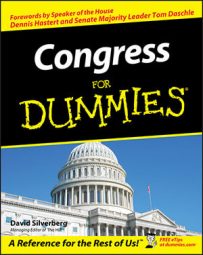As part of a balanced, three-branch system, with the American people serving as the big boss who hires them and can fire them at election time, Congress has to maintain working relationships with various bodies and constituencies.
House-Senate relations
Having been set up to provide checks and balances over one another, members of each chamber of Congress tend to get annoyed with each other. Members of the House tend to often get impatient with the Senate's slow deliberation and discussion of legislation, while senators tend to regard representatives as subject to popular whims and passions and lacking the necessary maturity for governance.
But other major differences between the two chambers are in keeping with their origins. In the Senate, everyone is equal, but in the House, the rule is by majority in keeping with the House's representative origins.
You see, in Washington they have these bodies, Senate and the House of Representatives. That's for the convenience of the visitors. If there's nothing funny happening in one, there's sure to be in the other, and in case one body passes a good bill, why, the other can see it in time and kill it. — Will Rogers, American humorist
Executive-congressional relations through the years
The legislative and executive branches are equal under the Constitution. The Constitution notwithstanding, the relationship among the branches, particularly the executive and legislative, is a constantly shifting one.
Generally, in times of peace and prosperity, Congress has been the more dominant institution. In times of war or danger, the executive branch is the dominant branch.
For much of early American history, the president was relatively powerless, and though not an unimportant figure, was secondary to Congress. From 1820 to 1860, as slavery, states rights, and enormous expansion threatened to tear the country apart, members of the Senate were the ones who kept the nation together with a series of compromises. Executive branch powers increased considerably during the Civil War, as President Abraham Lincoln commanded new resources and sought new authority to keep the union together.
After the Civil War, the relationship continued to change, and some great clashes and momentous events have taken place marking the legislative-executive relationship:
- In 1868, Congress passed a measure to prevent the president from removing cabinet officers without its approval. President Andrew Johnson believed that this was unconstitutional, defied the restriction, was impeached, and escaped removal by a single vote. (The president's position was later upheld by the Supreme Court.)
- In 1920, the Senate defeated President Woodrow Wilson's bid to have the United States join the League of Nations. The struggle between Wilson and Senator Henry Cabot Lodge (R-Mass., 1893-1924) marked a major shift in the center of gravity to the legislative branch.
- In 1933, President Franklin Roosevelt, boosted by Democratic gains in Congress, launched the New Deal to combat the Great Depression. This effort inaugurated a long period of executive branch activism and expansion that continued through World War II and the Cold War of the mid-20th century.
- In 1994, the overwhelming election of a Republican House and Senate marked a resurgent Congress whose struggle with the executive branch culminated in the 1999 impeachment of President Bill Clinton.
- In 2001, terrorist attacks on the United States and the launch of a war against terror inaugurated another period of executive activism at home and abroad.
The relationship between Congress and the executive branch changes every day.
Congressional-constituent relations
For elected officeholders who must provide what people want and reflect what they need, calibrating the popular mood is no easy task. It's part instinct, part empathy, part science, and part reading the newspapers and watching TV.
In addition to your expressions to them, your elected officials and those who would be your elected officials are always polling people to get their opinions on the issues of the day, or else they're holding focus groups to explore peoples' beliefs in depth.
When a federal official or candidate has this information, she has to absorb it and decide how to use it in order to get elected or stay elected. Your opinion is very important in formulating the party platform and the individual candidate's campaign.
Having said that, during the campaign, the candidate will promise you and everyone else the moon and stars to get elected. Most people don't trust campaign promises — and rightfully so. Promises are exaggerated during the campaign and are quickly forgotten as soon as the election is over.
However, a good politician tries to deliver on campaign promises on some level. To do that, though, a politician faces numerous obstacles, including the following:
- Opposition from opponents: Opponents may be from the other party, or they may be people within the candidate's own party who simply don't like another member's proposal.
- Institutional drag: Any organization must go through certain policies and procedures to get anything done, and some organizations take longer than others.
- Different leadership priorities: Party leaders in Congress may have other priorities or different priorities, or they may not support a member's agenda.
- Executive branch opposition: The president or executive branch agencies may oppose a member's efforts.
- Distractions: A member of Congress has to deal with many other priorities.
A member of Congress who delivers on campaign promises is one to be valued, and one who consistently fails to deliver doesn't deserve to stay in office — but a good faith effort and due diligence should count for something, too.

